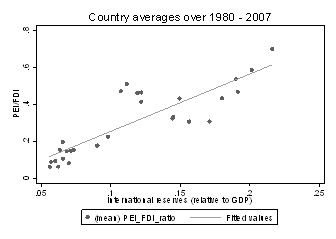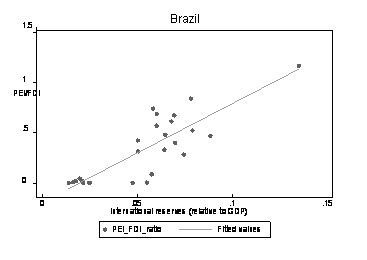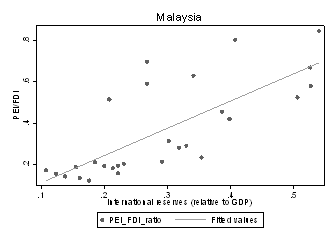By Xingwang Qian and Andreas Steiner
Today, we’re fortunate to have Xingwang Qian, Assistant Professor of Economics at SUNY Buffalo State and Andreas Steiner, Assistant Professor at University of Osnabrück
,
as Guest Contributors.
During the current tough economic situation in the industrial world, including the US and the Euro Zone, the global economic outlook increasingly depends on the performance of emerging economies: Their economic growth might propel the global economy out of a possible double-dipping recession. This hope is supported by the recent decoupling-recoupling debate, which argues that emerging economies’ business cycles might have become more independent of the economic situation in the industrial world.
Historically, one of the key factors that negatively affect emerging economies are financial crises caused by a sudden stop of short-term cross-border capital inflows. Prominent examples include the Mexican debt crisis in 1994 and the East Asian financial crisis in 1997. A financial crisis with self-fulfilling mechanism can lead to a large-scale capital reversal even in the absence of a shock to economic fundamentals (Caballero and Krishnamurthy, 2001). Thus, policies aiming at securing the stability of short-term capital inflows and maintaining a good investment environment in emerging markets seem to be among the key elements for both emerging economies themselves and the global economy as a whole. The hoarding of large stocks of international reserves might be instrumental to reach these goals.
Emerging economies hoard an incredibly large amount of more than 7 trillion USD of international reserves. Reserves increasingly have become a policy tool to stabilize the exchange rate and to self-insure the economy against financial crises. Research on international reserves has been quite active in recent years. However, many papers focus on explaining what determines the extraordinary reserve hoarding behavior in emerging markets.
In our study entitled “International Reserves and the Composition of Equity Capital Inflows”, rather than trying to explain the level of international reserves, we illustrate how the historically high level of international reserves in emerging economies may affect the global economy. More precisely, we focus on the effect of international reserves on the composition of equity capital inflows to emerging markets and the consequent implications for emerging markets and the global economy. Equity inflows, which comprise foreign direct investment (FDI) and portfolio equity investment (PEI), are the most important source of external financing for emerging markets; they accounted for 63% of total capital inflows to emerging markets over the period 2000 – 2010 (McKinsey Global Institute, 2011).

Figure 1: The composition of total capital inflows. Figure is copied from McKinsey Global Institute (2011).
FDI is relatively stable and resilient to financial crisis (Krugman, 2000), while PEI is volatile as investors can withdraw it easily and at low cost when expectations worsen. Hence, PEI is pro-crisis in the sense that more PEI inflows may imply a higher crisis probability and a deeper crisis if it materializes. International reserves, in turn, can insure against such sudden stops and mitigate their damage to economic growth (Aizenman and Marion, 2004; Frankel and Saravelos, 2010; Obstfeld et al., 2009). There seems to exist a dilemma: while international reserves are accumulated as an insurance against financial crises, they may attract more volatile PEI relative to stable FDI. Thus, for any emerging economy it is a pivotal policy question how to strike a balance between international reserves and capital flows and how to benefit most of them.
We use a simple theoretical model in which a risk-averse international investor has the choice between three different investment opportunities: an investment in FDI or PEI in an emerging economy or in the risk-free asset provided by the rest of the world. The result indicates that higher international reserves reduce the risk premium of PEI in an emerging economy, therefore making PEI a more attractive form of investment than FDI. In other words, theoretically, we can hypothesize that larger international reserves increase the share of PEI in total equity capital inflows.
We then check the empirical relevance of our theoretical finding using annual data of 23 emerging markets for the period from 1980 to 2007. FDI and PEI data are stock (or position) data from the EWN II data set of Lane and Milesi-Ferretti (2007). We first use data averaged across time for each country and data of two representative countries to visualize the bivariate relationship between international reserves and the ratio of PEI to FDI (see Figure 2). The graphs show a clearly positive correlation between international reserves and the ratio of PEI to FDI.



Figure 2: International reserves and the ratio of PEI to FDI.
We then use both static and dynamic panel regression methods. Our hypothesis is confirmed by the data: After controlling for other possible factors that might affect the composition of equity capital inflows, e.g. institutional quality, trade openness, capital controls, etc. we find a positive and significant effect of reserves on the ratio of PEI to FDI. The results are robust across different model specifications including alternate sets of control variables and across estimation procedures.
Our results have two major policy implications: On the one hand, central banks’ reserves offer benefits disregarded so far: By attracting PEI, they contribute to the development of domestic financial markets and facilitate domestic firms’ access to external financial resources. On the other, the findings reveal a possible dilemma for central banks: while their international reserves are intended to reduce crisis vulnerability, they attract precisely those capital flows that are crisis-prone.
References
Aizenman, Joshua and Nancy Marion (2004), “International reserve holdings with sovereign risk and costly tax collection”, Economic Journal 114: 569-591.
Caballero, Ricardo J. and Arvind Krishnamurthy (2001), “International and domestic collateral constraints in a model of emerging market crises”, Journal of Monetary Economics 48(3): 513-548.
Frankel, Jeffrey A. and George Saravelos (2012), “Are leading indicators of financial crises useful for assessing country vulnerability? Evidence from the 2009-09 global crisis”, Journal of International Economics, forthcoming.
Krugman, Paul (2000), “Fire-Sale FDI,” in: Paul Krugman, Capital flows and the emerging economies: theory, evidence and controversies, Chicago, pp. 43-60.
Lane, Philip R. and Gian Maria Milesi-Ferretti (2007), “The external wealth of nations mark II: Revised and extended estimates of foreign assets and liabilities, 1970–2004”, Journal of International Economics 73, November: 223-250.
McKinsey Global Institute (2011), “Mapping global capital market 2011”, McKinsey and Company.
Obstfeld, Maurice, Jay C. Shambaugh and Alan M. Taylor (2009), “Financials instability, reserves, and central bank swap lines in the panic of 2008”, American Economic Review: Papers and Proceedings, Vol. 99(2): 480-486.
Qian, Xingwang and Andreas Steiner (2012), “International Reserves and the Composition of Equity Capital Inflows”, Institute of Empirical Economic Research Working Paper No. 90, University of Osnabrueck.
This post written by Xingwang Qian and Andreas Steiner
Nicely written, nicely reasoned.
Interesting document from the IMF (COFER),supplying the international breakdown of foreign currencies holdings by categories hovering around 10 trillion usd for the world and 7 trillion usd for the emerging and developing economies.It provides as well questions, as to the relevance of the IMF currencies representations in the special drawing rights.
http://www.imf.org/external/np/sta/cofer/eng/cofer.pdf
When dealing with emerging economies as a set, their international reserves seem self sufficient, unless volatility is introduced by external or domestic factors.
Assets breakdown may be of relevance,knowing that the bonds markets are the transmission and catalysts of the financial crisis,1987 flows and outflows were driven by the bonds markets,1997 the same.Bonds volatility is a crucial precursor of crisis to come.How much of the reserves are built up from capital inflows,where are they invested?
According to a World Bank report.
“Chinese companies issued a record volume of international bonds in the first quarter of 2011, partly reacting to the increased cost and rationing of domestic finance following the government’s policies to curb credit growth. The pace of issuance has slowed considerably since January, partly reflecting the impact of increased uncertainty in global mark” IPOs and syndicated loans have not been in demand and foreign participations slowing,’cross-border syndicated bank loans and equity placements) to developing countries totaled $175 billion in the first four months of 2011, 24 percent less than the last four months of 2010″.
This report deals with the flows and not with the stocks.In a systemic financial crisis,the whole stratifications of assets will be shaken.The available free reserves will have to be recognized.
The turmoil in Europe was not driven by the trade breakdown but vanishing liquidities 1.5 trillion euros evaporating from the European zone,replenished through current accounts by 1 trillion euros.The international trade broke down for that particular reason i.e no liquidities.The preventive measures against destabilizing capital inflows as prescribed by the IMF,foreign exchanges appreciation,tightening fiscal policy,easing the monetary policies,the timing is left to the initiative of the countries.
Everything seems well but:
“Financial Stability in Emerging Markets: Dealing with Global Liquidity” Econbrowser
As outlined in the above post the current account to GDP ratio is not that large and declining to negative for most of the emerging economies China,Russia,Brazil,India(Fig 1)
Interesting.
From an investor’s standpoint, large reserves signal the host country can defend it’s currency should financial conditions deteriorate, so it makes sense that the authors’ model predicts a decrease in risk premium. They seem to view reserves more as a put option that hedges foreign investors against depreciation.
However, during boom times, large reserves accumulate as a country sells its own currency and buys foreign currency to prevent appreciation, so that its exports remain competitively priced.
The result is that large reserves are more like a futures contract than a put option. Large reserves reduce exchange rate volatility so they are more than just a hedge against depreciation, as the authors suggest. The virtual futures hedge from large reserves reduces exchange rate volatility making cash flows more certain and reduces the risk premium.
I think a better metric would be (total foreign currency debt)/(reserves), because it is the expected inability of the government to repay foregin creditors that initiates capital flight, loss of reserves and equity crashes that ultimately destroy the currency.
Steven, ppcm, and tj, thank you all for your nice and valuable comments. We try to respond to some of your questions as follow:
To ppcm: “How much of the reserves are built up from capital inflows, where are they invested?”
As you point out, the accumulation of reserves might be a reaction to capital inflows. Yes, we agree that central banks seem to use capital inflows to build up their reserves (another one is accumulating reserves in response to a current account surplus, e.g. the case of China). This allows the central bank to prevent (or limit) an exchange rate appreciation, which might be induced by capital inflows. Moreover, net capital inflows increase the external indebtedness of an economy. As a result, a precautionary central bank policy might consist in accumulating reserves when capital flows in such that it has the necessary resources to finance capital flows when capital may flow out in the future. To some extent, this may be called a “countercyclical” central bank policy. Indeed, empirical studies on the demand for reserves usually conclude that central banks increase their reserve hoardings when external debt increases.
As you point out, the volatility of capital flows is rooted in the volatility of bond flows. This is especially true if short-term bonds are the preferred to long-term ones. In a related paper (work in progress and we will make it public soon) we therefore analyse whether reserves affect the maturity structure of external debt. We find that reserves do favour short-term debt inflows.
To tj: “Large reserves reduce exchange rate volatility so they are more than just a hedge against depreciation, as the authors suggest.”
Concerning reserves’ interpretation as a put option rather than a futures contract, we totally agree that reserve accumulation limits the appreciation of the exchange rate. Hence, in periods when countries accumulate reserves they also prevent investors benefitting from a positive exchange rate development. In our theoretical model we account for these “two sides” of the game (see footnote 7). For our conclusions, however, we concentrate on the level of reserves which might be considered as an insurance against exchange rate depreciation. For your valid point, one had to focus on the change in the level of reserves.
“Emerging economies hoard an incredibly large amount of more than 7 trillion USD of international reserves. Reserves increasingly have become a policy tool to stabilize the exchange rate and to self-insure the economy against financial crises.”
No. The purpose of the reserves is to steal aggregate demand through currency manipulation. China never had a debt crisis.
“There seems to exist a dilemma: while international reserves are accumulated as an insurance against financial crises, they may attract more volatile PEI relative to stable FDI.”
International reserves accumulated to artificially depress the currency attracts speculative capital flows in anticipation of an eventual return of the currency to its free-market level.
The old canards used to explain foreign reserve accumulations, and the implicit denial of what is actualy happening, seem disingenuous. Sort of like those who would equate push-back against currency manipulation with “protectionism”